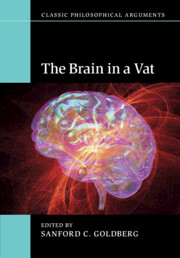Book contents
- Frontmatter
- Contents
- List of contributors
- Acknowledgments
- 1 Introduction: Putnam's reflections on the brain in a vat
- Part I Intentionality and the philosophy of mind and language
- Part II Epistemology
- 6 Putnam on BIVs and radical skepticism
- 7 New lessons from old demons: the case for reliabilism
- 8 BIVs, sensitivity, discrimination, and relevant alternatives
- Part III Metaphysics
- Bibliography
- Index
8 - BIVs, sensitivity, discrimination, and relevant alternatives
from Part II - Epistemology
Published online by Cambridge University Press: 05 June 2016
- Frontmatter
- Contents
- List of contributors
- Acknowledgments
- 1 Introduction: Putnam's reflections on the brain in a vat
- Part I Intentionality and the philosophy of mind and language
- Part II Epistemology
- 6 Putnam on BIVs and radical skepticism
- 7 New lessons from old demons: the case for reliabilism
- 8 BIVs, sensitivity, discrimination, and relevant alternatives
- Part III Metaphysics
- Bibliography
- Index
Summary
The central purpose of this chapter is to explore the implications of wedding the sensitivity principle in epistemology to the content externalism that serves as the engine of Putnam's brain-in-a-vat (BIV) argument. To a first approximation, the sensitivity principle says that S knows that p only if, were p false, S would not believe that p. Numerous criticisms of and counterexamples to sensitivity have appeared in the literature since it was first fully developed and defended by Nozick (1981). Most of these problems are well known, opinions differ on which if any are devastating, and it would take the space of a lengthy essay just to describe the objections and possible replies, let alone elucidate and assess them. So I won't do that. Instead, I aim to execute two tasks. In Section 8.1, I simply draw out the most direct anti-skeptical implications of sensitivity and content externalism, taken together. Many tangled questions arise about the cogency of arguments from content externalism and sensitivity to conclusions about knowledge of the external world. Particularly germane are questions about self-knowledge of thought contents. In Section 8.2, I focus on these questions. As we will see, on (what I shall call) the standard externalist view (Burge 1988), self-knowledge of content is possible even when one cannot distinguish one's actual thoughts from certain possible twin thoughts. Some philosophers are dubious, claiming that the standard view fails to account for the importance of a discriminating ability for self-knowledge of content. One might naturally think to turn to the sensitivity principle to illuminate self-knowledge of content, insofar as sensitivity appears both to imply a discrimination requirement on knowledge and to generate an account of the relevant alternatives that one's grounds for belief must be able to rule out in order for one's true belief to count as knowledge. I shall argue that this is a mistake. Sensitivity tells us no more about self-knowledge, and perhaps considerably less, than the standard externalist view.
Before moving on to the main program, let me elaborate on why one might think to turn to sensitivity in response to perceived deficiencies in the standard view of self-knowledge, which, again, and as I will explain below, accounts for non-empirical knowledge of the contents of one's own thoughts without requiring the capacity to discriminate, for example, the thought that water is wet from the Twin Earth thought that twater is wet.
- Type
- Chapter
- Information
- The Brain in a Vat , pp. 111 - 128Publisher: Cambridge University PressPrint publication year: 2016
- 1
- Cited by

